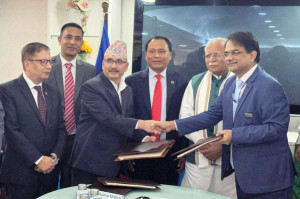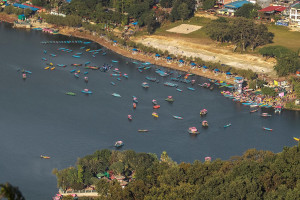Money
Bhairahawa airport may be operated by private sector
The government may make first airport deal under the public-private partnership (PPP) programme to operate Gautam Buddha International Airport in Bhairahawa, going against the tradition that airports should be owned, managed and operated by the government.
The government may make first airport deal under the public-private partnership (PPP) programme to operate Gautam Buddha International Airport in Bhairahawa, going against the tradition that airports should be owned, managed and operated by the government.
Located in south central Nepal, the airport is the gateway to the international pilgrimage destination of Lumbini, the birthplace of Gautam Buddha. It is in the process of being upgraded to an international airport, and the project is expected to be completed by June 2019.
In response to the view asked by the Finance Ministry on whether PPP deal would be appropriate in the context of Nepal, the National Planning Commission (NPC) said it would be wise to induct trustable domestic or international investment under the PPP model.
The NPC, the apex advisory body of the government for formulating periodic plans and policies, said that after the airport is constructed and if the existing government’s resources are not adequate, the airport operation could be entrusted to the private. “The private sector should be inducted through open competition,” the NPC letter obtained by the Post reads.
The planning body has asked the government to be clear on sharing the risks and benefits of the project, the role of the private sector, national and international airport operating laws, quality assurance and safety and security at the airport before inducting private investment.
According to the Tourism Ministry officials, private capital in airports around the world has delivered significant benefits for passengers, airlines and the government.
According to a World Bank report, approximately 19 percent of airports in the world are PPPs, accounting for 30 percent of total passengers. In India, the government has developed new airports or modernised existing airports in several cities on a PPP basis. In Nepal, what has made the government think that it is time to involve private players in airport operation and management? Many officials point to a chaotic Tribhuvan International Airport (TIA) and its infrastructure hurdles as the inspiration to reach out to the private sector.
The government is under heavy pressure to improve the efficiency of its existing sole international airport that is managed by the Civil Aviation Authority of Nepal (Caan).
Besides being known as one of the worst airports in the world in terms of comfort, cleanliness and customer service, TIA has reached its capacity limit. Its infrastructure is ill-equipped to deal with the growth in the number of airlines. “There is an urgent need to bring the private sector onboard to operate the country’s airports,” said a Tourism Ministry official.
The proposed Integrated Civil Aviation Bill has also envisaged allowing the private sector to build and operate airports. A draft of the new law looks kindly at potential privately operated airports, and it has also simplified the process for the government to privatise its existing airports.
The growth of Nepal’s air transport industry can be traced back to 1992 when the aviation policy was liberalised. Aircraft movement, both domestic and international, jumped more than fourfold from 24,600 in 1992 to 126,469 in 2017, according to TIA statistics.
Liberalisation in Nepal’s aviation scene opened the door for private operators, and a swarm of airlines entered the Nepali skies. The aviation sector is flying high, but infrastructural hurdles persist, and the service offered by government-managed airports remains poor.
Due to flip-flops in government policy, the country’s airport infrastructure and services have failed to match the pace of the booming airline industry.
The aviation industry has become very attractive for investors, but its potential remains constrained by limited infrastructure.




 15.12°C Kathmandu
15.12°C Kathmandu














